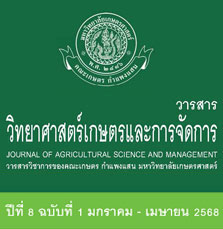Photosynthetic Light-Response Curve of Holy Basil (Ocimum tenuiflorum L.) under Different Levels of CO2 Concentrations
Keywords:
Holy basil, photosynthesis, light response curve, elevated CO2 concentrationAbstract
Light intensity and atmospheric CO2 concentration (Ca) play important roles in plant photosynthesis. The objectives of this research were to determine the light and CO2 requirements for maximal photosynthesis and to investigate the effect of elevated Ca on photosynthesis process in holy basil (Ocimum tenuiflorum L. ‘OC059’). We examined the response of photosynthetic rate under the different levels of light intensity from 0–2500 mmolPPF m-2 s-1 and Ca from 400–1600 mmolCO2 mol-1. The result indicated that the maximum gross photosynthetic rate (Amax) of holy basil was 35.0 mmolCO2 m-2 s-1 at ambient Ca (400 mmolCO2 mol-1). The light saturation point (Is) where the net photosynthetic rate (A) reached its maximum was 918.1 mmolPPF m-2 s-1 and the light compensation point (Ic) was 64.6 mmolPPF m-2 s-1. Increasing Ca induced stomatal closure in holy basil, the stomatal conductance (gs) decreased markedly with elevating the level of Ca. The Amax and Is increased with increasing Ca, whereas the quantum efficiency (a) and dark respiration rate (Rd) decreased. The optimal level of Ca for enhancing maximal photosynthesis in holy basil was 1000 mmolCO2 mol-1.
References
วินัย อุดขาว, ภฤศนันท์ เอี่ยมเอกสุวรรณ และสุนทรี ยิ่งชัชวาลย์. 2559. การตอบสนองของปากใบและกระบวนการสังเคราะห์แสงของยูคาลิปตัส คามาลดูเลนซิส ต่อสภาวะขาดน้ำจากการชักนำด้วยพอลิเอทิลีนไกลคอล. วารสารวิทยาศาสตร์เกษตร 47(2):149–161.
ศรีสังวาลย์ ลายวิเศษกุล และสุนทรี ยิ่งชัชวาลย์. 2554. เส้นตอบสนองต่อแสงของใบผักโขมภายใต้ความเข้มข้นหลายระดับของคาร์บอนไดออกไซด์. วารสารวิทยาศาสตร์เกษตร 42(2):193–202.
ศรีสังวาลย์ ลายวิเศษกุล และสุนทรี ยิ่งชัชวาลย์. 2559. ศักยภาพการสังเคราะห์แสงของใบธงของข้าวพันธุ์ กข41, ปทุมธานี1 และขาวดอกมะลิ105 ภายใต้การเพิ่มขึ้นของ CO2. วารสารวิทยาศาสตร์เกษตร 48(1):36–47.
Avola, G., V. Cavallaro, C. Patane` and E. Riggi. 2008. Gas exchange and photosynthetic water use efficiency in response to light, CO2 concentration and temperature in Vicia faba. Journal of Plant Physiology 165(8):796–804.
Barton, C.V.M., R.A. Duursma, B.E. Medlyn, D.S. Ellsworth, D. Eamus, D.T. Tissue, M.A. Adams, J. Conroy, K.Y. Crous, M. Liberloo, M. Löw, S. Linder and R.E. McMurtrie. 2012. Effects of elevated atmospheric [CO2] on instantaneous transpiration efficiency at leaf and canopy scales in Eucalyptus saligna. Global Change Biology 18(2):585–595.
Biehler, K and H. Fock. 1996. Evidence for the contribution of the mehler-peroxidase reaction in dissipating excess electrons in drought-stressed wheat. Plant Physiology 112(1):265–272.
Bowes, G. 1993. Facing the inevitable: plants and increasing atmospheric CO2. Annual Review of Plant Physiology and Plant Molecular Biology 44:309–332.
Dong, J., N. Gruda, S.K. Lam, X. Li and Z. Duan. 2018. Effects of elevated CO2 on nutritional quality of vegetables: A review. Frontiers in Plant Science 9(924):1–11.
Gestel, N.C., A.D. Nesbit, E.P. Gordon, C. Green, P.W. Pare, L. Thompson, E.B. Peffley and D.T. Tissue. 2005. Continuous light may induce photosynthetic downregulation in onion–consequences for growth and biomass partitioning. Physiologia Plantarum 125(2):235–246.
Imaizumi, T., P. Jitareerat, N. Laohakunjit and N. Kaisangsri. 2021. Effect of microwave drying on drying characteristics, volatile compounds and color of holy basil (Ocimum tenuiflorum L.). Agriculture and Natural Resources 55:1–6.
Lang, Y., M. Wang, G.C. Zhang and Q.K. Zhao. 2013. Experimental and simulated light responses of photosynthesis in leaves of three tree species under different soil water conditions. Photosynthetica 51(3):370–378.
Li, D., J. Dong, N.S. Gruda, X. Li and Z. Duan. 2022. Elevated root-zone temperature promotes the growth and alleviates the photosynthetic acclimation of cucumber plants exposed to elevated [CO2]. Environmental and Experimental Botany 194:1–16.
Mamatha, H., N.K. Srinivasa Rao, R.H. Laxman, K.S. Shivashankara, R.M. Bhatt and K.C. Pavithra. 2014. Impact of elevated CO2 on growth, physiology, yield, and quality of tomato (Lycopersicon esculentum Mill) cv. Arka Ashish. Photosynthetica 52(4):519–528.
Pan, T., Y. Wang, L. Wang, J. Ding, Y. Cao, G. Qin, L. Yan, L. Xi, J. Zhang and Z. Zou. 2020. Increased CO2 and light intensity regulate growth and leaf gas exchange in tomato. Physiologia Plantarum 168(3): 694–708.
Park, K.S., K. Bekhzod, J.K. Kwon and J.E. Son. 2016. Development of a coupled photosynthetic model of sweet basil hydroponically grown in plant factories. Horticulture Environment and Biotechnology 57(1):20–26.
Pérez-López, U., A. Robredo, M. Lacuesta, A. Mena-Petite and A. Mu˜noz-Rueda. 2009. The impact of salt stress on the water status of barley plants is partially mitigated by elevated CO2. Environmental and Experimental Botany 66(3):463–470.
Raksakantong, P., S. Siriamornpun, J. Ratseewo and N. Meeso. 2011. Optimized drying of kaprow leaves for industrial production of holy basil spice powder. Drying Technology 29:974–983.
Schreiber, U., W. Bilger, H. Hormann and C. Neubauer. 1998. Chlorophyll fluorescence as a diagnostic tool: basics and some aspects of practical relevance. pp. 320-336. in: A.S. Raghavendra (Ed.). Photosynthesis: A Comprehensive Treatise. Cambridge University Press, Cambridge.
Sharkey, T.D., C.J. Bernacchi, G.D. Farquhar and E.L. Singsaas. 2007. Fitting photosynthetic carbon dioxide response curves for C3 leaves. Plant, Cell and Environment 30(9):1035–1040.
Simkin, A.J., L. McAusland, L.R. Headland, T. Lawson and C.A. Raines. 2015. Multigene manipulation of photosynthetic carbon assimilation increases CO2 fixation and biomass yield in tobacco. Journal of Experimental Botany 66(13):4075–4090.
Song, H., P. Wu, X. Lu, B. Wang, T. Song, Q. Lu, M. Li and X. Xu. 2022. Comparative physiological and transcriptomic analyses reveal the mechanisms of CO2 enrichment in promoting the growth and quality in Lactuca sativa. PLOS ONE 18(2):e0278159. doi: 10.1371/journal.pone.0278159.
Taiz, L and E. Zeiger. 2006. Plant Physiology. 4th ed. Sinauer Associates, Inc. Publishers, Massachusetts. 764 p.
Thornley, J.H and I.R. Johnson. 1990. Plant and Crop Modeling — A Mathematical Approach to Plant and Crop Physiology. Clarendon Press, Oxford. UK. 660 p.
Vanaja, M., S.K. Yadav, G. Archana, N. Jyothi Lakshmi, P.R. Ram Reddy, P. Vagheera, S.K. Abdul Razak, M. Maheswari and B. Venkateswarlu. 2011. Response of C4 (maize) and C3 (sunflower) crop plants to drought stress and enhanced carbon dioxide concentration. Plant, Soil and Environment 57(5):207–215.
Wongpraneekul, A., T. Havananda and K. Luengwilai. 2022. Variation in aroma level of holy basil (Ocimum tenuiflorum L.) leaves is related to volatile composition, but not trichome characteristics. Journal of Applied Research on Medicinal and Aromatic Plants 27:1–8.
Zhao, D., K.R. Reddy, V.G. Kakani, A.R. Mohammed, J.J. Read and W. Gao. 2004. Leaf and canopy photosynthetic characteristics of cotton (Gossypium hirsutum) under elevated CO2 concentration and UV-B radiation. Journal of Plant Physiology 161(5):581–590.






